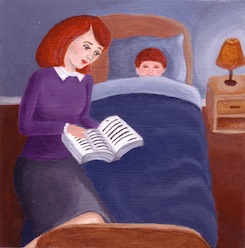8 Ways to Help Kids Fall Asleep Faster
 Children are so busy with activities these days that often they aren’t getting enough sleep, according to a study done by University of Michigan Health System. To help kids fall asleep faster and get the necessary sleep that they need to grow and learn properly, check out the following 8 suggestions.
Children are so busy with activities these days that often they aren’t getting enough sleep, according to a study done by University of Michigan Health System. To help kids fall asleep faster and get the necessary sleep that they need to grow and learn properly, check out the following 8 suggestions.- Avoid watching TV an hour before bedtime.While some activities stimulate the body, such as sports and being physically active in general, others stimulate the mind. Watching television is one such activity that stimulates the mind, and can hinder the body’s ability to relax and fall asleep. Depending on what your child is watching, it can also be the cause of nightmares or disturbing dreams that keep him awake at night or it could just make it difficult for him to wind down. Turn the TV off an hour before bedtime so he has plenty of time to wind down for the night.
- Keep a consistent bed time. According to WebMD keeping a consistent bedtime is imperative to raising healthy kids. WebMD also recommended waking up at the same time each morning as well. Varying your child’s waking time more than 60 to 90 minutes, even on the weekend, should be avoided. When the body gets out of its sleep routine it can be much harder for him to fall asleep.
- Give your child a healthy bedtime snack. Children typically have high metabolisms and will have burned through what they ate for supper before it’s time to go to bed, so it’s a good idea to give them a small healthy snack before bedtime. Kids who go to bed hungry will not sleep well. Try to give your child some protein and a carb. Whole grain crackers with cheese would work, or half a sandwich made with whole grain bread and peanut butter and a glass of low-fat milk. An apple with some peanut butter would also be an appropriate choice.
- Create a bedtime routine. Use the things that work for your lifestyle and your child and form a nightly routine. This consistency will help him be ready for bed each night. Your routine may include a healthy snack an hour before bed, followed by a warm bath and story time. You may finish your routine by turning on a fan or other white noise maker to block out sounds. The routine should be something that can be done in a short amount of time, and should be something that is easily done no matter where you are so that if you are travelling you can continue to follow the same bedtime procedure for your child.
- Read to the child to help him relax. Reading a story to a child while he is in bed will help him to forget about the events from the day and focus on the story. The relaxing tones of your voice can help put him at ease and get ready for sleep. Avoid scary stories at bedtime so as to not cause bad dreams. Stories not only help children relax, but they foster a love of reading.
- Turn on white noise to block outside sounds. Avoid having a television, radio, or music on when the children are falling asleep. If you have to have music on, make sure that it’s soothing and that it’s the same music every night. When the music is different it becomes a distraction and the kids are listening to the music instead of falling asleep. By using a white noise machine or a fan you will effectively avoid over stimulating the kids at bedtime while still blocking out sounds from the rest of the house. Small portable white noise machines are now available for travelling.
- Give them a warm bath before bed. Giving baths as part of a bedtime routine is recommended by Dr. Jodi Mindell from Johnson’s. The warm water is soothing and relaxing for the child. Even the change in temperature from the warmth of the water to the coolness outside the bath will actually cause the child to become tired. Allowing a baby to play in the bath at bedtime is a smart strategy to tire them out.
- Make the room a comfortable temperature. Making sure the room is not too warm or too cold will allow the child to be comfortable when he is trying to fall asleep. A comfortable temperature is typically between 68-70 degrees Fahrenheit. If a child is too cold they will stiffen and curl into a ball, which is not relaxing. If he is too warm he will be sweating and thrashing off the covers trying to get cool. Neither extreme is helpful when trying to get your child to sleep.
Children who are well rested are able to get the sleep needed to grow and develop properly and focus on learning. If your child is having trouble getting the sleep he needs, these 8 tips should help.
Source: http://www.liveinnanny.com/blog/8-ways-to-help-kids-fall-asleep-faster/
No comments:
Post a Comment